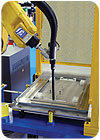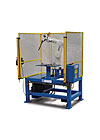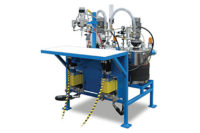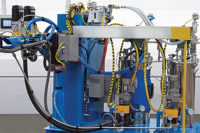
Manufacturers using adhesives and sealants in their product-assembly process must choose more than just the right bonding, sealing, gasketing or potting material. They must also select the proper dispensing equipment to use and the best method for applying the material. Product manufacturers also want to ensure that their dispensing equipment technology and application technology is efficient and meets their final part cost requirements. In addition, they must also analyze their return on investment, a complex task considering all the variables involved; in many cases, lower cost equipment can cause higher production and part cost than high-cost capital equipment.
The best time to evaluate a change in the fluid-dispensing process is when the customer and manufacturer want one or more of the following: better part quality, more part variety, lower part cost, less scrap, fewer spare parts, less maintenance, reduced labor or more parts per hour. Each of these desired improvements can be addressed, but with a different level of fluid-dispensing equipment and automation technology. Product issues can be resolved as the fluid-dispensing process equipment moves higher on the application technology scale. Delaying improvements to the dispensing process keeps issues and costs high, and invites loss of business. The equation is simple: change equals change.
Many manufacturers put off changing their manufacturing equipment because it’s difficult to evaluate and difficult to justify the expense. Fluid-dispensing process changes are commonly made in production when the manufactured product is in trouble. At this point, the troubled dispensing process is usually robbing production of product quality, uptime, parts and maintenance, profits, and sometimes customer orders.

Application Process Equipment Selection
Adhesive and sealant application equipment should be matched to the product and the process requirements, including part quality and total part cost. Production plans that include future growth in part rate, quality increases and cost reduction should seriously consider using a simple or intricate robotic dispensing process. Manufacturers dispensing multiple adhesives and sealants should think about different dispensing processes to match each dispensing application.There are three basic dispensing processes. Manual dispensing is used when the operator controls the flow rate, volume dispensed and bead profile, and includes using cartridge guns or pumps and manual fluid valves. Quality and part rate are typically low, but part cost is high. Semi-automatic dispensing is selected when the material flow and volume is machine-controlled, but the operator controls the location of the part, dispense start, and material placement. In this case, part quality and cost is improved. Robotic or fully automatic dispensing is chosen when the material flow and volume is machine controlled and integrated with the robot applicator and part location fixture or tooling; either the dispenser moves to the part or the part moves to the dispenser, and the integrated system deposits the material onto the part. The dispense start process is actuated with the part located in the dispense position. The operator only controls the loading and unloading of the parts. Here, part quality is highest and cost is lowest.

Higher Technology Equipment Can Lower Part Cost
Upgrading dispensing technology normally increases capital improvement costs, but resolves production issues - and can lower total part cost. It’s important to evaluate the return on investment of new materials, dispensing equipment and application methods for your process in order to define total part cost. This will determine if the new process equipment and materials will improve or eliminate product concerns. Evaluate the savings per part per year considering the costs of your current process components compared to your new process components. You may be surprised by how much you can save and improve production by exploring more sophisticated levels of dispensing equipment. Evaluate labor, adhesives, sealants, machinery, maintenance, spare parts, material and part scrap to determine total part cost before and after. The ideal payback on new dispensing equipment and application systems is 6-12 months.It’s important to determine how many different parts can be processed by a robotic dispensing system, which can further lower total part cost. For example, when upgrading to a robotic dispensing system, evaluate how many different parts needing one or more fluids dispensed can be handled by one fixture and one robot. How many different fluids are needed per part, and how many can be combined per station? Fixtures can be designed to hold multiple parts, where each unique part can trigger its own fluid-dispense program. In some cases, two different fluids can be dispensed onto the same part by the same robot to significantly improve process efficiency and cost.
Following are three examples where manufacturers met new production requirements by first evaluating and then upgrading to manual-load, semi-automatic or robotic automation dispensing systems.
Case Study 1: Upgrading Electric Coil Batch Dispensing Process
A manufacturer wanted to upgrade from manual to semi-automatic dispensing for an electric coil potting operation. They wanted low-cost precision volume filling and had more than a dozen different-sized components. The parts were batch processed and individually potted, which required a precise fluid flow rate to ensure that no air pockets occurred in the coil during dispensing to lower scrap cost and warranty issues. The process equipment included a positive-displacement meter-mix dispense system and an electrically controlled and integrated rotary turntable fixture.The operator would load the tooling for the part, load the coil assembly on the tooling and foot-pedal start the meter-mix dispense process. The turntable rotates to the correct speed and the dispensing system applies the pre-selected volume in the part. The table stops and the part is unloaded. This semi-automatic design uses nozzle position, precise flow rate, rotational force of the part and machine-controlled fluid volume to ensure quality potting of the coil and reduced product failures.
Case Study 2: Upgrading to Three Individual Dispensing Stations
Another manufacturer, after an ROI evaluation, selected manual-load robot automation dispensing for potting and gasketing electronic modules. Each part has three fluid applications using two different materials. They needed to increase part quality and jobs per hour.Three robot automation fixtures were engineered in which each fixture had its own meter-mix dispensing system using a common supply. The company bought small 6-axis robots, and the dispensing equipment supplier engineered the robot automation fixture, which integrated the systems and programmed the bead paths. This manual-load robot automation design provided the highest precision fluid volume and bead path while meeting the production rate with the lowest cost per part.
Case Study 3: Combining Multi-Processes into One Dispensing Station
This manufacturer wanted an electronic module and a metal cover applied with the same adhesive in two separate steps. The parts could either be batched or alternating. They wanted to upgrade from manually applying adhesive, increase the production rate, and have the electronic module adhesive applied with consistent precision to reduce scrap and warranty costs. The company asked the dispensing-equipment supplier to engineer the entire system, including the robot, manual dual-load part fixture, meter-mix dispense system, system integration, tooling, and bead-path programming. This design significantly reduced the overall cost by applying adhesive to two different parts with one robot automation system.Summary
Manufacturers considering a change in their fluid-dispensing process should first define their dispensing issues and production-process requirements. Then, contact an experienced dispensing-equipment manufacturer who can provide expert engineering and experience in simple and complex robot automation, as well as part fixtures, system integration, and robot bead path programming and technical support.For more information, visit www.SealantEquipment.com or e-mail sales@sealantequipment.com.

